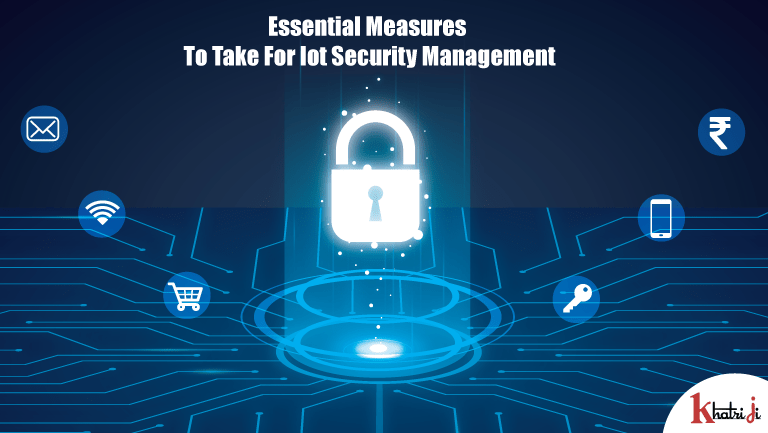IoT security is the act of securing Internet of Things gadgets and the network they’re associated with. In the business setting, IoT gadgets incorporate industrial machines, smart energy grids, building automation, in addition to whatever individual IoT gadgets bring to work. But is IoT secured? And if not what measures should we take?
IoT security is a growing concern now. Here’s the reason.
Your connected devices gather information. The personal data is gathered and stored within these gadgets — for example, your name, age, health, location, and much more. But this is helpful to criminals in retrieving or stealing your information.
Simultaneously, the Internet of Things is a developing trend, with a surge of new items hitting the market. Yet, here’s an issue: When you’re connected with multiple devices, there are numerous ways to retrieve your data. This is something, that can make you an alluring object-for the ones who want to take the benefit of your personal information. Thus, IoT is not secured.
Each IoT connected device you own; is an additional protection concern-since majority of them interface with your smartphone, smartwatches, and smart homes. Here are the means through which it works. Regardless of whether you need to check the cameras in your home, lock or unlock a door, change temperature or lighting, pre-heat the oven, or switch ON or OFF a TV. You can do it all distantly with just a few taps on your IoT enabled devices. Businesses use wide range of IoT devices, including trackers for vehicles, security cameras with sensors – that can capture data about industrial machinery. While the government applications include trackers to monitor wildlife, traffic and also natural disaster alerts.
The more functionality you add to your smart IoT based devices, the more information you store in the gadget. This could make the IoT device and others associated with them vulnerable against various cyber or information leak attacks.
What are the Biggest Obstacles with IoT? What are the threats?
IoT devices were not made keeping security in mind. In most cases, it is unlikely to install the security on the device itself. These devices transport malware with them at times, which will then contaminate the network they are associated with. Some of the network security does not check if any other IoT device gets connected to it also.
- The IoT devices consist of a large amount of personal data, including browsing/purchasing records, credit/debit card details, and other private information. This unsecured device leaves confidential information open for the thief to steal. Moreover, these vulnerable IoT devices can be used as gateways to other networks they are connected with, allowing more sensitive data to be extracted.
- The IoT devices are commonly used in the medical industry, it mainly incorporates pacemakers, defibrillators, heart monitors. However, all of them are vulnerable to security threats. Such improperly secured instruments can be programmed and implanted in the patient’s body. It can then be used to track the patient’s whereabouts.
- Insecure IoT devices are vulnerable to getting hijacked and used in DDoS (distributed denial of service) – a collection of malware-infected internet-connected devices in large numbers and are controlled from remote locations. A DDoS attack is a nasty attempt to make a server or a network resource unavailable to users. It is achieved by saturating a service, which results in its temporary suspension or interruption. This took down the most popular domains in the world including Etsy, GitHub, Netflix, Spotify, and Twitter.
The above highlights indicate that IoT is not secured. However, there are some protective measures we should take for security purposes.
Essential measures: We should take for IoT security management
IoT technologies are most dangerous to the internet. Reports say that threats have gone from an IoT botnet bringing down segments of the Internet to programmers misusing child screens. That is the reason it’s a smart thought to ensure your advanced life, by securing your IoT-connected devices. The sheer volume of Internet of Things gadgets focuses on their security and is vital for the future prosperity of the internet ecosystem.
For the device users, this implies that maintaining fundamental security is the best practice, for example, changing default security passwords and blocking unnecessary remote access (e.g., when not needed for a gadget’s usefulness). Merchants and device manufacturers, then again, should adopt an extensive strategy and invest in making sure about IoT management tools.
Here are different ways to do that.
- Prefer to use highly-secured software on your computer, tablets, smartphones.
- Make sure to have a strong and unique password for your device accounts. Be it a Wi-Fi network and other connected devices. Don’t use a password that can be guessed easily. Try to strengthen the password by adding an alphanumeric number in between.
- Always read the privacy policy before installing any app on your device and check how they use your information and more.
- Do your research before buying any product like: how these IoT devices will collect data, how the data will be stored and protected. If that data is to be shared with a third-party, then do check the policies or the protection-related norms to data breaches.
- Know what information or data is being accessed from the device or the app. If found unnecessary or appears risky then deny the permission.
- Use trustworthy VPN – Virtual Private Network, that can help to secure the data transmitted at your home or Wi-Fi. VPN extends a private network across a public network and enables users to send and receive data across shared or public networks. It acts as if their computing devices were directly connected to the private network.
- Keep a regular check on the device manufacturer’s website through firmware updates.
- Be cautious while using social sharing features with these apps that can expose your private information like location and let others know when you are not at home. Cyber criminals can track this record and can also stalk you or other dangers too.
- Turn off your Wi-Fi or Bluetooth access while in public places, thereby, not allowing auto connectivity or sharing your information with other users. Do not leave your Smartphone unattended if you are in public places.
These are few of the simplest actions to perform. However, with an increase in consumption of IoT-enabled products, it is critical to gauge the expense of security risks before its implementation.
Read More
- The Internet of Things(IoT) in Today’s World
- Role of Digital India in Economic Growth of the Nation
- What is Recharge API Services?
- Trending online industries post Covid-19 outbreak
- 6 Reasons : Why Work From Office is Better than WFH
Tags: home iot security, internet of things security, iot device security, iot home security, iot security challenges, iot security issues, iot security solutions, iot security standards, reason of iot security



